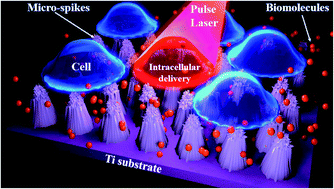Fabrication of TiO2 microspikes for highly efficient intracellular delivery by pulse laser-assisted photoporation
Abstract
The introduction of foreign cargo into living cells with high delivery efficiency and cell viability is a challenge in cell biology and biomedical research. Here, we demonstrate a nanosecond pulse laser-activated photoporation for highly efficient intracellular delivery using titanium dioxide (TiO2) microspikes as a substratum. The TiO2 microspikes were formed on titanium (Ti) substrate using an electrochemical anodization process. Cells were cultured on top of the TiO2 microspikes as a monolayer, and the biomolecule was added. Due to pulse laser exposure of the TiO2 microspike–cell membrane interface, the microspikes heat up and induce cavitation bubbles, which rapidly grow, coalesce and collapse to induce explosion, resulting in very strong fluid flow at the cell membrane surface. Thus, the cell plasma membrane disrupts and creates transient nanopores, allowing delivery of biomolecules into cells by a simple diffusion process. By this technique, we successfully delivered propidium iodide (PI) dye in HeLa cells with high delivery efficiency (93%) and high cell viability (98%) using 7 mJ pulse energy at 650 nm wavelength. Thus, our TiO2 microspike-based platform is compact, easy to use, and potentially applicable for therapeutic and diagnostic purposes.



 Please wait while we load your content...
Please wait while we load your content...